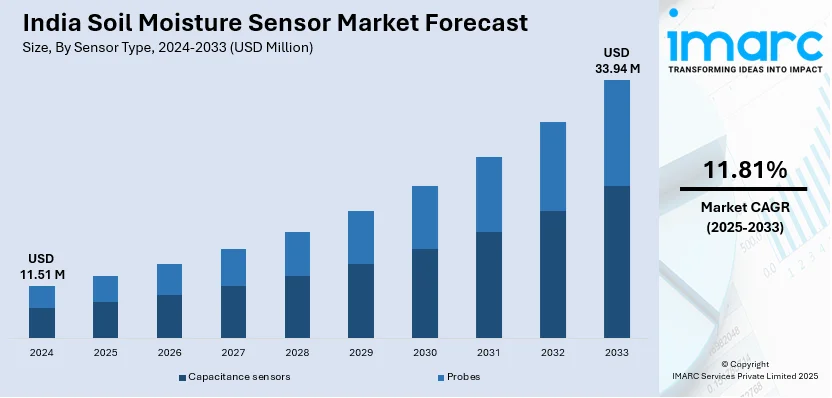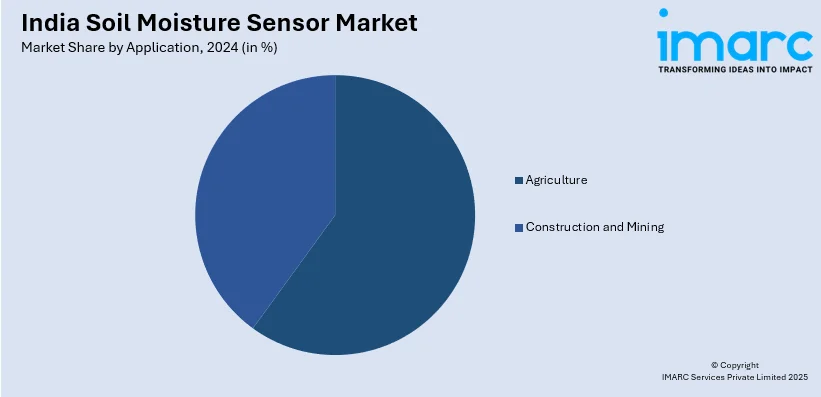
India Soil Moisture Sensor Market Size, Share, Trends and Forecast by Sensor Type, Connectivity, Application, and Region, 2025-2033
India Soil Moisture Sensor Market Overview:
The India soil moisture sensor market size reached USD 11.51 Million in 2024. Looking forward, IMARC Group expects the market to reach USD 33.94 Million by 2033, exhibiting a growth rate (CAGR) of 11.81% during 2025-2033. The market involves increasing adoption of precision agriculture, growing concerns over water conservation, and government initiatives promoting smart irrigation. Rising demand from horticulture and commercial farming, advancements in Intent of Things (IoT)-enabled sensors, and expanding rural internet connectivity further aiding the market growth, enhancing efficiency and sustainability in agriculture.
|
Report Attribute
|
Key Statistics
|
|---|---|
|
Base Year
|
2024
|
|
Forecast Years
|
2025-2033
|
|
Historical Years
|
2019-2024
|
| Market Size in 2024 | USD 11.51 Million |
| Market Forecast in 2033 | USD 33.94 Million |
| Market Growth Rate (2025-2033) | 11.81% |
India Soil Moisture Sensor Market Trends:
Increasing Adoption of Precision Agriculture
The Indian government's ₹6,000 crore allocation for precision farming is accelerating the adoption of smart technologies, including IoT, artificial intelligence (AI), drones, and data analytics, across the agriculture sector. This push aligns with the rising demand for soil moisture sensors, as farmers seek to optimize irrigation and boost crop yields. With erratic monsoons and falling groundwater levels, precision irrigation is becoming essential. Sensors integrated with IoT-based systems allow real-time monitoring, reduce water waste, and improve efficiency. Government support and rising awareness are encouraging farmers to adopt data-driven practices. Agritech startups and private firms are developing cost-effective sensor solutions suited for small and marginal farmers. As adoption grows, these technologies are enabling informed irrigation scheduling and better soil health management, supporting a shift toward sustainable, tech-enabled farming across India.

Expansion of Wireless and IoT-Enabled Sensors
The transition to wireless and IoT-based soil moisture sensors is picking up speed in India's agricultural and landscaping industries. The new sensors give real-time information on the soil, doing away with manual monitoring and allowing remote access via mobile apps. AI and cloud computing further increase the precision of soil moisture analysis. With growing penetration of smartphones among farmers and extending rural internet access, the penetration of smart irrigation solutions is on the rise. The cost-effectiveness of IoT-based systems is also increasing with manufacturers targeting price-friendly solutions for small-scale cultivation. With greater automation in the agricultural sector continuing to expand, the demand for wireless soil moisture sensors will surely increase, thereby enhancing efficiency as well as conservation of water on a national scale.
Rising Demand from Horticulture and Commercial Farming
Growing use of soil moisture sensors in horticulture and commercial agriculture is influencing the Indian market. Fruits, vegetables, and floriculture are high-value crops that need accurate moisture levels to produce quality and consistent yields. Greenhouses and polyhouses, depending on controlled irrigation, are using advanced moisture-sensing technology to improve water use. Besides, agribusiness firms and commercial large-scale farms are also investing in automated irrigation systems with moisture sensors to boost productivity. The trend is also being encouraged by government subsidies and research efforts advocating for effective water management techniques. With increasing demand for high-quality agricultural produce, the contribution of soil moisture sensors to maintaining the best growing conditions is becoming more and more important.
India Soil Moisture Sensor Market Segmentation:
IMARC Group provides an analysis of the key trends in each segment of the market, along with forecasts at the region level for 2025-2033. Our report has categorized the market based on sensor type, connectivity, and application.
Sensor Type Insights:
- Capacitance sensors
- Probes
The report has provided a detailed breakup and analysis of the market based on the sensor type. This includes capacitance sensors, and probes.
Connectivity Insights:
- Wired
- Wireless
A detailed breakup and analysis of the market based on the connectivity have also been provided in the report. This includes wired, and wireless.
Application Insights:

- Agriculture
- Construction and Mining
The report has provided a detailed breakup and analysis of the market based on the application. This includes agriculture, and construction and mining.
Regional Insights:
- North India
- South India
- East India
- West India
The report has also provided a comprehensive analysis of all the major regional markets, which include North, South, East, and West India.
Competitive Landscape:
The market research report has also provided a comprehensive analysis of the competitive landscape. Competitive analysis such as market structure, key player positioning, top winning strategies, competitive dashboard, and company evaluation quadrant has been covered in the report. Also, detailed profiles of all major companies have been provided.
India Soil Moisture Sensor Market News:
- In March 2025, The NASA-ISRO NISAR mission, launching this year, will map farmland, track crop growth, and monitor soil moisture using synthetic aperture radar. It will provide detailed insights on planting, irrigation, and farm management by imaging Earth’s land twice every 12 days at a 30-foot resolution. The data will help farmers and policymakers optimize agriculture, from small farms to large regions, improving crop health and resource management globally.
- In October 2024, Sensaphone launched a new soil moisture sensor to help growers, landscapers, and farmers optimize irrigation. The sensor provides real-time moisture data, integrating with Sensaphone monitoring systems to prevent over- or underwatering. It works with irrigation controllers to conserve water and reduce fertilizer runoff. Pre-calibrated for various soil types, it operates in extreme temperatures, making it ideal for greenhouses, cannabis farms, and golf courses.
India Soil Moisture Sensor Market Report Coverage:
| Report Features | Details |
|---|---|
| Base Year of the Analysis | 2024 |
| Historical Period | 2019-2024 |
| Forecast Period | 2025-2033 |
| Units | Million USD |
| Scope of the Report |
Exploration of Historical Trends and Market Outlook, Industry Catalysts and Challenges, Segment-Wise Historical and Future Market Assessment:
|
| Sensor Types Covered | Capacitance sensors, Probes |
| Connectivity’s Covered | Wired, Wireless |
| Applications Covered | Agriculture, Construction and Mining |
| Regions Covered | North India, South India, East India, West India |
| Customization Scope | 10% Free Customization |
| Post-Sale Analyst Support | 10-12 Weeks |
| Delivery Format | PDF and Excel through Email (We can also provide the editable version of the report in PPT/Word format on special request) |
Key Questions Answered in This Report:
- How has the India soil moisture sensor market performed so far and how will it perform in the coming years?
- What is the breakup of the India soil moisture sensor market on the basis of sensor type?
- What is the breakup of the India soil moisture sensor market on the basis of connectivity?
- What is the breakup of the India soil moisture sensor market on the basis of application?
- What is the breakup of the India soil moisture sensor market on the basis of region?
- What are the various stages in the value chain of the India soil moisture sensor market?
- What are the key driving factors and challenges in the India soil moisture sensor market?
- What is the structure of the India soil moisture sensor market and who are the key players?
- What is the degree of competition in the India soil moisture sensor market?
Key Benefits for Stakeholders:
- IMARC’s industry report offers a comprehensive quantitative analysis of various market segments, historical and current market trends, market forecasts, and dynamics of the India soil moisture sensor market from 2019-2033.
- The research report provides the latest information on the market drivers, challenges, and opportunities in the India soil moisture sensor market.
- Porter's five forces analysis assist stakeholders in assessing the impact of new entrants, competitive rivalry, supplier power, buyer power, and the threat of substitution. It helps stakeholders to analyze the level of competition within the India soil moisture sensor industry and its attractiveness.
- Competitive landscape allows stakeholders to understand their competitive environment and provides an insight into the current positions of key players in the market.
Need more help?
- Speak to our experienced analysts for insights on the current market scenarios.
- Include additional segments and countries to customize the report as per your requirement.
- Gain an unparalleled competitive advantage in your domain by understanding how to utilize the report and positively impacting your operations and revenue.
- For further assistance, please connect with our analysts.
 Inquire Before Buying
Inquire Before Buying
 Speak to an Analyst
Speak to an Analyst
 Request Brochure
Request Brochure
 Request Customization
Request Customization




.webp)




.webp)












